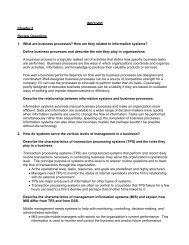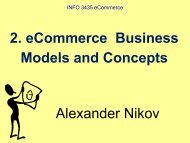Create successful ePaper yourself
Turn your PDF publications into a flip-book with our unique Google optimized e-Paper software.
INFO 3435 eCommerce10. <strong>Online</strong> Retail <strong>and</strong> ServicesAlex<strong>and</strong>er Nikov
Outline1. The <strong>Online</strong> Retail Sector2. Analyzing the Viability of <strong>Online</strong> Firms3. eCommerce in Action: E-tailing Business Models4. The Service Sector: Offline <strong>and</strong> <strong>Online</strong>5. <strong>Online</strong> Financial Services6. <strong>Online</strong> Travel Services7. <strong>Online</strong> Career Services10-2
Teaching Objectives• Describe the environment in which the online retail sector operatestoday.• Explain how to analyze the economic viability of an online firm.• Identify the challenges faced by the different types of online retailers.• Describe the major features of the online service sector.• Discuss the trends taking place in the online financial <strong>services</strong> industry.• Describe the major trends in the online travel <strong>services</strong> industry today.• Identify current trends in the online career <strong>services</strong> industry.10-3
Blue Nile Sparkles For Your CleopatraClass Discussion• Why is selling (or buying) diamonds over the Internet difficult?• How has Blue Nile built its supply chain to keep costs low?• How has Blue Nile reduced consumer anxiety over online diamondpurchases?• What are some vulnerabilities facing Blue Nile?• Would you buy a $5,000 engagement ring at Blue Nile?10-4
1. The <strong>Online</strong> Retail SectorOutline2. Analyzing the Viability of <strong>Online</strong> Firms3. eCommerce in Action: E-tailing Business Models4. The Service Sector: Offline <strong>and</strong> <strong>Online</strong>5. <strong>Online</strong> Financial Services6. <strong>Online</strong> Travel Services7. <strong>Online</strong> Career Services10-5
10-7
The Retail Industry• 7 segments (clothing, durable goods, etc.)– For each, uses of Internet may differ• Information vs. direct purchasing• General merch<strong>and</strong>isers vs. specialtyretailers• Mail order/telephone order (MOTO) sectormost similar to online retail sector– Sophisticated order entry, delivery, inventorycontrol systems10-9
Composition of the U.S. Retail IndustryFigure 9.1, Page 579SOURCE: U.S. Census Bureau, 2012.10-10
E-commerce Retail: The Vision1. Reduced search <strong>and</strong> transaction costs; customersable to find lowest prices2. Lowered market entry costs, lower operating costs,higher efficiency3. Traditional physical store merchants forced out ofbusiness4. Some industries would be disintermediated• Few of these assumptions were correct—structure ofretail marketplace has not been revolutionized• Internet has created new venues for multichannel firms<strong>and</strong> supported a few pure-play merchants10-11
The <strong>Online</strong> Retail Sector Today• Smallest segment of retail industry (5-6%)• Growing at faster rate than offline segments• Revenues expected to resume 10-15% growth between2010 – 2014• Around 72% of Internet users bought online in 2012• Primary beneficiaries:– Established offline retailers with online presence(e.g. Staples)– First mover dot-com companies (e.g. Amazon)10-12
<strong>Online</strong> Retail <strong>and</strong> B2C eCommerceIs Alive <strong>and</strong> WellFigure 9.2, Page 578SOURCES: Based on data from eMarketer, Inc., 2012a; authors’ estimates..10-13
10-14
Multi-Channel Integration• Integrating Web operations with traditional physical storeoperations– Provide integrated shopping experience– Leverage value of physical store• Types of integration– <strong>Online</strong> order, in-store pickup– Web promotions to drive customers to stores– Gift cards usable in any channel• Increasing importance of mobile devices, commerce,<strong>and</strong> tablets10-15
10-16
Outline1. The <strong>Online</strong> Retail Sector2. Analyzing the Viability of <strong>Online</strong> Firms3. eCommerce in Action: E-tailing Business Models4. The Service Sector: Offline <strong>and</strong> <strong>Online</strong>5. <strong>Online</strong> Financial Services6. <strong>Online</strong> Travel Services7. <strong>Online</strong> Career Services10-17
Analyzing the Viability of <strong>Online</strong> Firms• Economic viability:– Ability of firms to survive as profitable business firmsduring specified period (i.e., 1–3 years)• Two business analysis approaches:1. Strategic analysis• Focuses on both industry as a whole <strong>and</strong> firm itself2. Financial analysis• How firm is performing10-18
Strategic Analysis Factors• Key industry strategic factors– Barriers to entry– Power of suppliers– Power of customers– Existence of substitute products– Industry value chain– Nature of intra-industry competition• Strategic factors related to specific firm– Firm value chain– Core competencies– Synergies– Technology– Social <strong>and</strong> legal challenges10-19
Outline1. The <strong>Online</strong> Retail Sector2. Analyzing the Viability of <strong>Online</strong> Firms3. eCommerce in Action: E-tailing Business Models4. The Service Sector: Offline <strong>and</strong> <strong>Online</strong>5. <strong>Online</strong> Financial Services6. <strong>Online</strong> Travel Services7. <strong>Online</strong> Career Services10-20
Financial Analysis Factors• Statements of Operations– Revenues– Cost of sales– Gross margin– Operating expenses– Operating margin– Net margin• Pro forma earnings• Balance sheet– Assets, current assets– Liabilities, current liabilities <strong>and</strong> long-term debt– Working capital10-21
E-tailing Business Models• Four main online retail business models:1. Virtual merchant• Amazon2. Bricks-<strong>and</strong>-clicks• Wal-Mart, J.C. Penney, Sears3. Catalog merchant• L<strong>and</strong>s’ End, L.L. Bean, Victoria’s Secret4. Manufacturer-direct• Dell10-22
E-commerce in Action: Amazon.com• Vision:– Earth’s biggest selection, most customer-centric• Business model:– Amazon Retail, Third Party Merchants, <strong>and</strong> Amazon WebServices (merchant <strong>and</strong> developer <strong>services</strong>)• Financial analysis:– Continued explosive revenue growth, profitable• Strategic analysis/business strategy:– Maximize sales volume, cut prices• Strategic analysis/competition:– <strong>Online</strong> <strong>and</strong> offline general merch<strong>and</strong>isers, Web <strong>services</strong>10-23
E-commerce in Action: Amazon.com• Strategic analysis/technology:– Largest, most sophisticated collection of online <strong>retailing</strong>technologies available• Strategic analysis/social, legal:– Antitrust, sales tax, patent lawsuits• Future prospects:– In 2011, net sales grew 40%, <strong>and</strong> significant gains thusfar in 2013– Ranks among top five in customer service, speed,accuracy– However, net margins still much narrower than Wal-Mart10-24
10-25
10-26
Common Themes in <strong>Online</strong> Retailing• <strong>Online</strong> retail fastest growing channel on revenue basis• Profits for startup ventures have been difficult to achieve• Disintermediation has not occurred• Established merchants need to create integratedshopping experience to succeed online• Growth of online specialty merchants, e.g. Blue Nile• Extraordinary growth of social, local, <strong>and</strong> mobile e-commerce10-27
Outline1. The <strong>Online</strong> Retail Sector2. Analyzing the Viability of <strong>Online</strong> Firms3. eCommerce in Action: E-tailing Business Models4. The Service Sector: Offline <strong>and</strong> <strong>Online</strong>5. <strong>Online</strong> Financial Services6. <strong>Online</strong> Travel Services7. <strong>Online</strong> Career Services10-28
The Service Sector: Offline <strong>and</strong> <strong>Online</strong>• Service sector:– Largest <strong>and</strong> most rapidly exp<strong>and</strong>ing part ofeconomies of advanced industrial nations– Concerned with performing tasks in <strong>and</strong> aroundhouseholds, business firms, <strong>and</strong> institutions• Includes doctors, lawyers, accountants, businessconsultants, etc.– Employs 4 out of 5 U.S. workers– 75% of economic activity10-29
Service Industries• Major service industry groups:– Finance– Insurance– Real estate– Travel– Professional <strong>services</strong>—legal, accounting– Business <strong>services</strong>—consulting, advertising,marketing, etc.– Health <strong>services</strong>– Educational <strong>services</strong>10-30
Service Industries• Companies can be further categorized as:– Transaction brokers– H<strong>and</strong>s-on service providers• Services industry features:– Knowledge- <strong>and</strong> information-intense• Makes them uniquely suited to e-commerce applications– Amount of personalization <strong>and</strong> customization required differsdepending on type of service• E.g., medical <strong>services</strong> vs. financial <strong>services</strong>10-31
Outline1. The <strong>Online</strong> Retail Sector2. Analyzing the Viability of <strong>Online</strong> Firms3. eCommerce in Action: E-tailing Business Models4. The Service Sector: Offline <strong>and</strong> <strong>Online</strong>5. <strong>Online</strong> Financial Services6. <strong>Online</strong> Travel Services7. <strong>Online</strong> Career Services10-32
<strong>Online</strong> Financial Services• Example of e-commerce success story, but success issomewhat different from what had been predicted• Brokerage industry transformed• 62% of customers prefer online banking• Effects less powerful in insurance, real estate• Multi-channel established financial <strong>services</strong> firmscontinue to show strong growth10-33
Financial Service Industry Trends• Two important global trends1. Industry consolidation• Financial Reform Act of 1998 amended Glass-Steagall Act <strong>and</strong> allows banks, brokerages, <strong>and</strong>insurance firms to merge2. Movement toward integrated financial <strong>services</strong>• Financial supermarket model10-34
10-35
Industry Consolidation <strong>and</strong> IntegratedFinancial ServicesFigure 9.3, Page 60910-36
<strong>Online</strong> Financial Consumer Behavior• Consumers attracted to online financial sites because ofdesire to save time <strong>and</strong> access information rather than savemoney• Most online consumers use financial <strong>services</strong> firms formundane financial management• Check balances• Pay bills• Number of people using mobile devices for financial<strong>services</strong> is surging10-37
10-38
<strong>Online</strong> Banking <strong>and</strong> Brokerage• <strong>Online</strong> banking pioneered by NetBank <strong>and</strong> Wingspan; nolonger in existence• Established br<strong>and</strong>-name national banks have takensubstantial lead in market share• 107 million people use online banking; expected to rise to116 million by 2014• Early innovators in online brokerage (E*Trade) have alsobeen displaced by established brokerages (Fidelity,Schwab)10-39
10-40
The Growth of <strong>Online</strong> BankingFigure 9.4, Page 610 SOURCE: Based on data from comScore, 2010, eMarketer, Inc., 2010b.10-41
Multi-channel vs.Pure <strong>Online</strong> Financial Service Firms• <strong>Online</strong> consumers prefer multi-channel firms withphysical presence• Multi-channel firms– Growing faster than pure online firms– Lower online customer acquisition costs• Pure online firms– Cannot provide all <strong>services</strong> that require face-to-faceinteraction10-42
10-43
Financial Portals <strong>and</strong> Account Aggregators• Financial portals– Comparison shopping <strong>services</strong>, independent financial advice<strong>and</strong> financial planning– Revenues from advertising, referrals, subscriptions– E.g., Yahoo! Finance, Quicken.com, MSN Money• Account aggregation– Pulls together all of a customer’s financial data at a personalizedWeb site– E.g., Yodlee: provides account aggregation technology– Privacy concerns; control of personal data, security, etc.10-44
<strong>Online</strong> Mortgage <strong>and</strong> Lending Services• Early entrants hoped to simplify <strong>and</strong> speed up mortgage valuechain– Difficulties of developing br<strong>and</strong> <strong>and</strong> simplifying mortgagegeneration process• Three kinds of online mortgage vendor today1. Established online banks, brokerages, <strong>and</strong> lendingorganizations2. Pure online mortgage bankers3. Mortgage brokers• <strong>Online</strong> mortgage industry has not transformed process ofobtaining mortgage– Complexity of process10-45
<strong>Online</strong> Insurance Services• <strong>Online</strong> term life insurance:• One of few products for which Internet lowered searchcosts, increased price comparison, <strong>and</strong> resulted in lowerprices• Commodity• Most insurance not purchased online• <strong>Online</strong> industry geared more toward• Product information, search• Price discovery• <strong>Online</strong> quotes• Influencing the offline purchasing decision10-46
10-47
10-48
<strong>Online</strong> Real Estate Services• Early vision: local, complex, <strong>and</strong> agent-driven real estateindustry would transform into disintermediated marketplacewhere buyers <strong>and</strong> sellers would transact directly• However, major impact is influencing of purchases offline– Impossible to complete property transaction online– Main <strong>services</strong> are online property listings, loancalculators, research, <strong>and</strong> reference material, with mobileapps increasing• Despite revolution in available information, there has notbeen a revolution in the industry value chain10-49
10-50
10-51
Outline1. The <strong>Online</strong> Retail Sector2. Analyzing the Viability of <strong>Online</strong> Firms3. eCommerce in Action: E-tailing Business Models4. The Service Sector: Offline <strong>and</strong> <strong>Online</strong>5. <strong>Online</strong> Financial Services6. <strong>Online</strong> Travel Services7. <strong>Online</strong> Career Services10-52
<strong>Online</strong> Travel Services• One of most successful B2C e-commerce segments• <strong>Online</strong> travel bookings declined slightly due to recessionbut expected to grow to $150 billion in 2016• For consumers: More convenience than traditional travelagents• For suppliers: A singular, focused customer pool that canbe efficiently reached through onsite advertising10-53
<strong>Online</strong> Travel Services• Travel an ideal service/product for Internet– Information-intensive product– Electronic product—travel arrangements can beaccomplished for the most part online– Does not require inventory– Does not require physical offices with multiple employees– Suppliers are always looking for customers to fill excesscapacity– Does not require an expensive multi-channel presence10-54
<strong>Online</strong> Travel Services RevenuesFigure 9.5, Page 618SOURCE: Based on data from eMarketer, 2012d.10-55
• Four major sectors:• Airline ticketsThe <strong>Online</strong> Travel Market• Hotel reservations• Car rentals• Cruises/tours• 57% purchase airline tickets from airline’s Website, 22% from travel booking Web site (e.g.,Expedia)• Corporate online-booking solutions (COBS)• Integrated travel <strong>services</strong>10-56
ProjectedGrowth of<strong>Online</strong> TravelMarketSegmentsFigure 9.6, Page 625SOURCES: Based on data from eMarketer, Inc., 2010c.10-57
<strong>Online</strong> Travel Industry Dynamics• Intense competition among online providers• Price competition difficult• Industry consolidation– Stronger, offline established firms purchasing weakeronline firms to create multi-channel travel sites• Industry impacted by meta-search engines– Commoditize online travel• Mobile applications are also transforming industry• Social media content, reviews have an increasing influenceon travel purchases10-58
10-59
The Travel Services Value ChainFigure 9.7, Page 62810-60
Outline1. The <strong>Online</strong> Retail Sector2. Analyzing the Viability of <strong>Online</strong> Firms3. eCommerce in Action: E-tailing Business Models4. The Service Sector: Offline <strong>and</strong> <strong>Online</strong>5. <strong>Online</strong> Financial Services6. <strong>Online</strong> Travel Services7. <strong>Online</strong> Career Services10-61
<strong>Online</strong> Career Services• Top sites generate over $1 billion annually• Two main players: CareerBuilder, Monster• Traditional recruitment:– Classified, print ads, career expos, on-campus recruitment,staffing firms, internal referral programs• <strong>Online</strong> recruiting– More efficient, cost-effective, reduces total time-to-hire– Enables job hunters to more easily distribute resumes whileconducting job searches– Ideally suited for Web due to information-intense nature ofprocess10-62
It’s Just Information:The Ideal Web Business?• Recruitment ideally suited for Web– Information-intense process– Initial match-up doesn’t require much personalization• Saves time <strong>and</strong> money for both job hunters <strong>and</strong>employers• One of the most important functions:– ability to establish market prices <strong>and</strong> terms (onlinenational marketplace)10-63
10-64
10-65
Recruitment Market Segments• Three major segments1. General job recruitment:• Largest segment <strong>and</strong> primary focus2. Executive search:• Highest revenue potential3. Specialized job placement <strong>services</strong>:• Often run by professional societies• <strong>Online</strong> recruitment has focused on general job market, butincreasing <strong>services</strong> for executive recruiting10-66
<strong>Online</strong> Recruitment Industry Trends• Consolidation:– CareerBuilder <strong>and</strong> Monster together dominate the market• Diversification: niche employment sites• Localization:– Local boards compete with local newspapers, Craigslist• Job search engines/aggregators:– “Scraping” listings: Indeed.com, JobCentral• Social networking:– LinkedIn; Facebook apps• Mobile Web sites <strong>and</strong> apps10-67
















